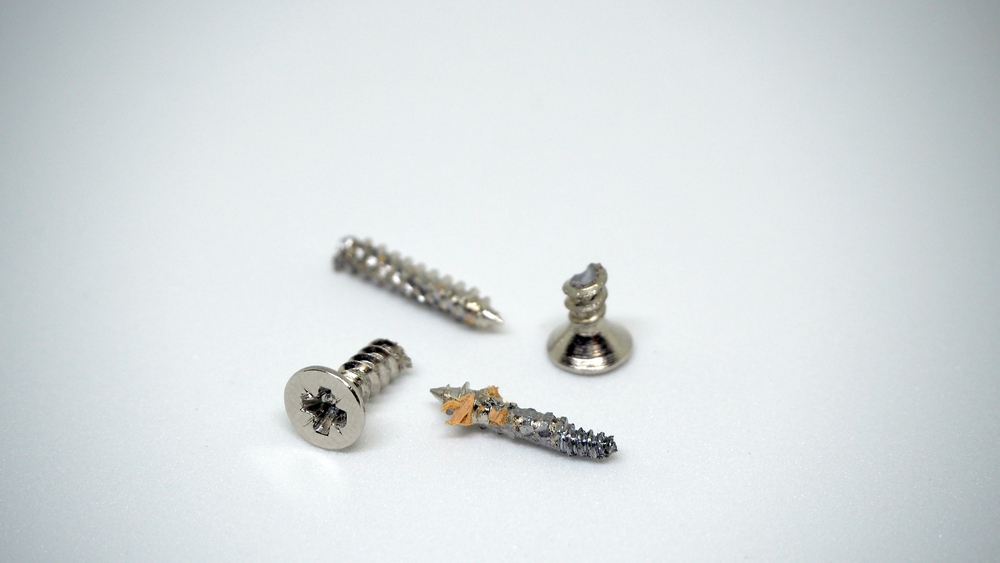Screws save lives. Broken screws can do the opposite. On the other hand, when we depend on screws to hold everything, removing the screw without a head can be messy. Fixing that takes a long time! If these sound familiar, read on.
Drilling inside broke your screw. Probably brittle. Maybe you exerted more pressure. Let’s examine the main causes of such issues:
Overstressing anything is bad. Internal and external stress may affect these bolts. Overstressing them may break them.
Pressure: Overusing a screwdriver, whether manually or electrically, can break it. Especially with electrical drivers, pressure must be controlled.
Corrosion: Oxygen, oils, etc. weaken and destroy screws. These weaken and break down.
Fatigue: Screw lifespans vary. Over time, they tyre and break more easily. Thus, they must be replaced soon.
These factors cause screw breakage, especially the head. Well, what could a screw without a head cause? Damage to the material where it’s inserted, difficulty in extracting, difficulty in replacing, difficulty in covering, and it may not be in the right place.
How to remove the broken screw head? Top 10 problem-solving tips.
10 Easy Ways to Remove Broken-Headed Screws
Let’s analyse each hack.
Screw Extractor
Have you noticed that screw extractors twist left, opposite screws? That’s our method! The screw extractor size is critical. Once found, attach them to drill machines and reverse them. Screw extractors drill in reverse to remove screws.
Extract It
Use screw drillers wisely to remove screws with broken heads. Remove the drill head and attach it to the screw if the screw is not too deep. If the screw is too deep, drill a pilot hole to remove it. Though destructive, this may not be the worst option.
Rubber Band Rescue
This hack is best if you have an elastic rubber band! Use a wide rubber band to cover the screw. Drive the screwdriver with the rubber band over the screw hole. The elastic band will tighten the grip around the screw. Drive the screw and rubber band out slowly. Avoid losing the rubber band’s grip.
Screwdriver Sizes
We try complicated hacks but miss simple ones. If your screw has at least 1% of its head left, a different size screwdriver may help. Try smaller sizes until the screw head fits. Avoid damaging the remaining screw. Screwdrivers can remove broken-headed screws.
Screw Extractor Pliers
If your screw head has not sunk deep into the material, you may not be screwed! Pliers can remove screws above the surface or just inside. Secure the plier to the screw. Take a firm grip or it may break again, worsening the condition. Plier-pull the screw. Screw extracting pliers are designed for this. To avoid damage, use a screwdriver after getting it out.
Superglue
If the screw remains stuck after all these, try superglue without damaging the area. Drop two or three drops of superglue inside the screw head and stick the driver to it. Dry glue. Push the driver down afterward to secure it. Rotate the screw slowly. If the attachment stays, screw it outside. Repeat until the grip is strong.
Plug Cutters
If the screw is deep inside a wood piece and impossible to remove, get destructive. Wood plug cutters scrape around screws as they remove them. Read on if you don’t mind destroying the screw without a head.
Adjust the drill’s plug cutter around the screw. As the drill descends, scrape. Continue until the cutter is screw-deep. Clean it. After cleaning, the screw can be easily accessed and pulled out using any device or the hacks above.
Nut-welding
Welding a nut on top of the bolt is a great way to remove the screw without a head. If you have the tools, this method may work if the screw head is too deep to pull out with pliers. Make sure the nut fits the threaded bolt and is the right size. High-temperature welding helps. This could loosen bolts.
Dremel Cutters
Finding tools can be difficult. Use what you have—finding what you need can be a treasure hunt. A cutting wheel on a rotating machine or Dremel can simplify your work. Place the wheel on top of the worn head and make a slit with minimal damage. After that, any screwdriver should be able to remove it. Wear goggles to protect your eyes from scrapings.
Hammer It
Though difficult, this process is possible with some planning. The metal must be soft enough to scrape the head, so you must remove the screw headless. This property may work. Hammer in a screwdriver above the threaded screw head. Safely do it. The screwdriver should grip the screw from within. Once you have a good grip, slowly rotate it and pull it out.
Why Not Cover?
These hacks are useful, but unless it’s necessary, cover the screw with no head. Leave it and cover it with levelling or filling material. This hides the screw completely.
These hacks may not work for all threaded screw heads. The choice depends on the stage:
- It’s above the base level—try pliers, screwdrivers, or a hammer.
- Base level: Remove it with a cutting wheel or super glue.
- It’s inside the level—try a different screwdriver.
- Use the elastic rubber band to place it at a medium height inside. Screw extractor works too.
- Wood plug cutters can reach it deep inside the level. Try other methods to avoid destruction.
These hacks solved your broken screw-without-head problem.






